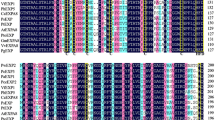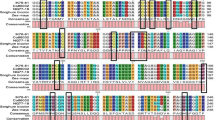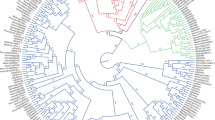Abstract
Achyranthes bidentata, a traditional perennial medicine herb in China, contains a rich source of important pharmaceutically active phytoecdysteroids including 20-hydroxyecdysone (20E). The growth of A. bidentata plants and 20E production are suppressed under abiotic stress condition. Expansins are plant cell wall-loosening proteins to play important roles in different environment stresses. In this study, we tried to clone an expansin gene (designed as AbEXP) from A. bidentata and characterize its transcriptional response to abiotic stresses (salt stress and nutrient deficiency). The cDNA of AbEXP contained 1584 nucleotides with a complete opening reading frame of 786 nucleotides to encode a peptide of 261 amino acids. The expression of the gene was detected in stems, roots or leaves, and was relatively abundant in stems. The expression levels of AbEXP under the salinity stress (25 mM NaCl) were increased 51.7-folds in roots but decreased in stems significantly. P and K deficiency enhanced the expression of AbEXP in roots and stems, but down-regulated the levels in leaves compared with control conditions. Under N deficiency AbEXP expression levels in roots and leaves were down-regulated by 9.95-fold and 4.58-fold, respectively. The expression level in roots was 43.9-fold of the control level under Fe deficiency while no significant changes of the expression were detected in stems and leaves. Although the growth of A. bidentata seedlings was inhibited under both the salinity stress and nutrient deficiency, 20E content in roots was enhanced significantly under N and P deficiency. These results demonstrate that AbEXP could be involved in the responses to abiotic stresses and manipulation of the gene expression of AbEXP could promote growth and 20E production of A. bidentata.





Similar content being viewed by others
References
Abbasi GH, Akhtar J, Anwar-Ul-Haq M, Malik W, Ali S, Chen ZH, Zhang GP (2015) Morpho-physiological and micrographic characterization of maize hybrids under NaCl and Cd stress. Plant Growth Regul 75:1–8
Buchanan CD, Lim S, Salzman RA, Kagiampakis I, Morishige DT, Weers BD (2005) Sorghum bicolor’s transcriptome response to dehydration, high salinity and ABA. Plant Mol Biol 58:699–720
Chen YH, Han YY, Kong XZ, Kang HH, Ren YQ, Wang W (2016) Ectopic expression of wheat expansin gene TaEXPA2 improved the salt tolerance of transgenic tobacco by regulating Na+/K+ and antioxidant competence. Physiol Plant 159:161–177
Chishaki N, Horiguchi T (1997) Responses of secondary metabolism in plants to nutrient deficiency. Soil Sci Plant Nutr 43:987–991
Cho HT, Kende H (1997) Expression of expansin genes is correlated with growth in deepwater rice. Plant Cell 9:1661–1671
Choi D, Cho HT, Lee Y (2006) Expansins: expanding importance in plant growth and development. Physiol Plant 126:511–518
Cosgrove DJ (1998) Cell wall loosening by expansins. Plant Physiol 118:333–339
Cosgrove DJ (2000) Loosening of plant cell walls by expansins. Nature 407:321–326
Cosgrove DJ (2015) Plant expansins: diversity and interactions with plant cell walls. Curr Opin Plant Biol 25:162–172
Dinan L, Lafont R (2006) Effect and applications of arthropod steroid hormones (ecdysteroids) in mammals. J Endocrinol 191:1–8
Ding XS, Duan HY, Song JY, He YL, Duan ZQ, Li XW (2010) Effects of NaCl stress on seed germination, root growing and content of trace element on Achyranthes bidentata Bl. J Henan Agric Sci 4:91–94 (Chinese)
Duan HY, Ding XS, Song JY, He YL, Zhou YQ (2013) Plant regeneration and Agrobacterium-mediated transformation of Achyranthes bidentata using cotton EREBP gene. Braz Arch Biol Technol 56:349–356
Duan HY, Ding XS, Song JY (2014) Effects of abiotic stress on seed germination and root growth of Achyranthes bidentata. Bulg J Agric Sci 20:342–347
Gnanaraj WE, Antonisamy JM, Mohanamathi RB, Subramanian KM (2012) In vitro clonal propagation of Achyranthes aspera L. and Achyranthes bidentata Blume using nodal explants. Asian Pac J Trop Biomed 2:1–5
Han YY, Li AX, Li F, Zhao MR, Wang W (2012) Characterization of a wheat (Triticum aestivum L.) expansin gene, TaEXPB23, involved in the abiotic stress response and phytohormone regulation. Plant Physiol Biochem 54:49–58
Jelali N, Wissal M, Dell’Orto M, Abdelly C, Gharsalli M, Zocchi G (2010) Changes of metabolic responses to direct and induced Fe deficiency of two Pisum sativum cultivars. Environ Exp Bot 68:238–246
Jia HF, Wang JA, Yang YY, Liu GS, Bao Y, Cui H (2015) Changes in flavonol content and transcript levels of genes in the flavonoid pathway in tobacco under phosphorus deficiency. Plant Growth Regul 76:225–231
Lafont R, Dinan L (2003) Practical uses for ecdysteroids in mammals including humans: an update. J Insect Sci 3:1–30
Li JT, Teng HM, Hu ZH (2007) Accumulation dynamic of ecdysterone in vegetative organs of Achranthes bridentata. Chin Tradit Herb Drugs 38:1570–1573 (Chinese)
Li XX, Zhao J, Walk TC, Liao H (2014) Characterization of soybean β-expansin genes and their expression responses to symbiosis, nutrient deficiency, and hormone treatment. Appl Microbiol Biotechnol 98:2805–2817
Li JT, Wang C, Han XP, Qi WZ, Chen YQ, Wang TX, Zheng Y, Zhao XT (2016) Transcriptome analysis to identify the putative biosynthesis and transport genes associated with the medicinal components of Achyranthes bidentata Bl. Front Plant Sci 7:1860
Medina-Pérez V, López-Laredo AR, Sepúlveda-Jiménez G, Zamilpa A, Trejo-Tapia G (2015) Nitrogen deficiency stimulates biosynthesis of bioactive phenylethanoid glycosides in the medicinal plant Castilleja tenuiflora Benth. Acta Physiol Plant 37:93
Meng DL, Li X (2000) The research development of Achyranthes bidentata Bl. Chin J Med Chem 2:120–124 (Chinese)
Min JK, Yun HS, Kaufman PB, Chang SC, Kim GK (2005) Two expansins, EXP1 and EXPB2, are correlated with the growth and development of maize roots. J Plant Biol 48:304–310
Murashige T, Skoog F (1962) A revised medium for rapid growth and bioassays with tobacco tissue cultures. Physiol Plant 15:473–497
Sampedro J, Cosgrove DJ (2005) The expansin superfamily. Genome Biol 6:242
Shcherban TY, Shi J, Durachko DM, Guiltinan MJ, McQueen-Mason SJ, Shieh M, Cosgrove DJ (1995) Molecular cloning and sequence analysis of expansins–a highly conserved, multigene family of proteins that mediate cell wall extension in plants. Proc Natl Acad Sci USA 92:9245–9249
Tang WC, Eisenbrand G (1992) Chinese drugs of plant origin: chemistry, pharmacology and medicinal use in traditional and modern medicine. Springer, Berlin, pp 13–18
Tenhaken R (2015) Cell wall remodeling under abiotic stress. Front Plant Sci 5:771
Thiem B, Kikowska M, Maliński MP, Kruszka D, Napierała M, Florek E (2016) Ecdysteroids: production in plant in vitro cultures. Phytochem Rev. doi:10.1007/s11101-016-9483-z
Wang JW, Wu JY (2013) Effective elicitors and process strategies for enhancement of secondary metabolite production in hairy root cultures. Adv Biochem Eng Biotechnol 134:55–89
Wang QJ, Zheng LP, Sima YH, Yuan HY, Wang JW (2013) Methyl jasmonate stimulates 20-hydroxyecdysone production in cell suspentsion cultures of Achyranthes bidentata. Plant Omics 6:116–120
Wang QJ, Zheng LP, Zhao PF, Zhao YL, Wang JW (2014) Cloning and characterization of an elicitor-responsive gene encoding 3-hydroxy-3-methylglutaryl coenzyme A reductase involved in 20-hydroxyecdysone production in cell cultures of Cyanotis arachnoidea. Plant Physiol Biochem 84:1–9
Wang QJ, Lei XY, Zheng LP, Wang JW (2017) Molecular characterization of an elicitor-responsive 3-hydroxy-3-methylglutaryl coenzyme A reductase gene involved in oleanolic acid production in cell cultures of Achyranthes bidentata. Plant Growth Regul 81:335–343
Wu Y, Cosgrove DJ (2001) Modification of expansin transcript levels in the maize primary root at low water potentials. Plant Physiol 126:1471–1479
Wu Y, Meeley RB, Cosgrove DJ (2001) Analysis and expression of the α-expansin and β-expansin gene families in maize. Plant Physiol 126:222–232
Xu B, Gou JY, Li FG, Shangguan XX, Zhao B, Yang CQ, Wang LJ, Yuan S, Liu CJ, Chen XY (2013a) A cotton burp domain protein interacts with α-expansin and their co-expression promotes plant growth and fruit production. Mol Plant 6:945–958
Xu Q, Xu X, Shi Y, Xu JC, Huang BR (2013b) Transgenic tobacco plants overexpressing a grass PpEXP1 gene exhibit enhanced tolerance to heat stress. PLoS ONE 9:e100792
Zhang HR, Lan JX, Fu SL, Gao ZM (2010) Study on growth and development characteristics of different breeding types of Achyranthes bidentata. Chin Agric Sci Bull 6:118–121
Zhou J, **e JN, Liao H, Wang XR (2014) Overexpression of β-expansin gene GmEXPB2, improves phosphorus efficiency in soybean. Physiol Plant 150:194–204
Acknowledgements
This work was supported by the National Natural Science Foundation of China (No. 81473183), Soochow Scholar Program (No. 14317363) and the Postgraduate Research & Practice Innovation Program of Jiangsu Province.
Author information
Authors and Affiliations
Corresponding author
Electronic supplementary material
Below is the link to the electronic supplementary material.
Rights and permissions
About this article
Cite this article
Lei, X.Y., Wang, Q.J., Wang, J.W. et al. Cloning and characterization of an expansin gene AbEXP from Achyranthes bidentata . Plant Growth Regul 83, 479–487 (2017). https://doi.org/10.1007/s10725-017-0313-0
Received:
Accepted:
Published:
Issue Date:
DOI: https://doi.org/10.1007/s10725-017-0313-0




